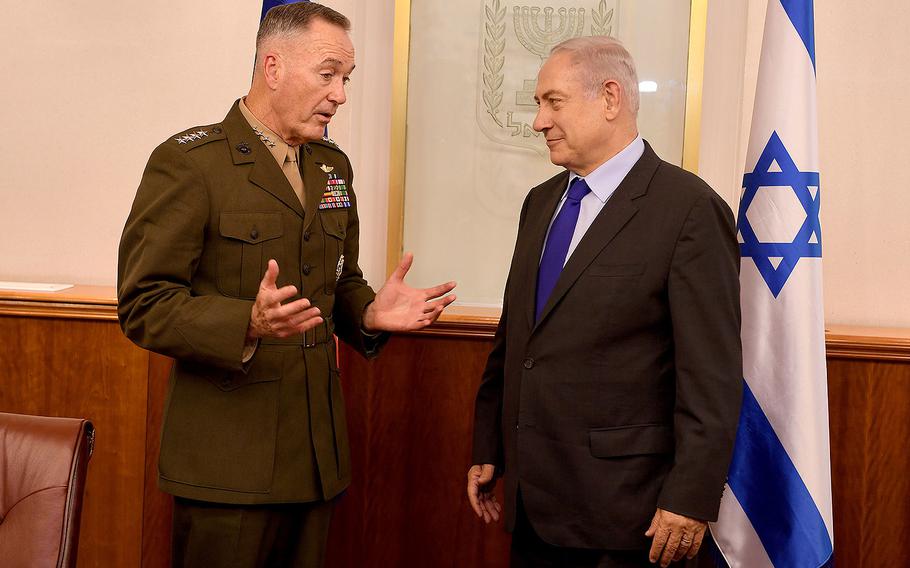
Gen. Joseph Dunford, chairman of the Joint Chiefs of Staff, meets Israeli Prime Minister Benjamin Netanyahu at his office in Jerusalem on May 9, 2017. (Matty Stern/U.S. Embassy)
JERUSALEM — The number of troops that the United States will add to the fight in Afghanistan will depend on how many additional forces NATO supplies to expand the battle against terrorists there, Marine Gen. Joseph Dunford, chairman of the Joint Chiefs of Staff, said Tuesday.
President Donald Trump’s administration was close to approving an agreement that would potentially send several thousand additional U.S. forces to Afghanistan, according to reports Monday in The New York Times and The Washington Post.
However, Dunford told reporters traveling with him in Israel that the number of U.S. forces to be deployed has not been decided and Trump has not yet been briefed on the Pentagon's new plan for Afghanistan. The plan will include how many troops are needed to fulfill the NATO-led train-and-advise mission and strengthen the U.S. counterterrorism effort, Dunford said.
Together, the two missions need about 15,000 troops, he said. There are about 8,400 U.S. forces and 4,900 NATO forces in Afghanistan now.
However, Dunford said the plan could be altered to require more than 15,000 troops.
The plan also will address what additional authorities forces will need to counter Taliban gains made in the last year, Dunford said. He and Defense Secretary Jim Mattis are planning to brief Trump later this week on the plan for Afghanistan.
"We've been talking Afghanistan for weeks," with the principals of Trump's National Security Council, Dunford said. "Now we've gotten to the point where the national security adviser [Army Lt. Gen. H.R. McMaster] will facilitate a meeting with the president."
But Dunford stressed the plan to increase forces in Afghanistan does not mean more U.S. troops, necessarily. Dunford said he hopes to brief Trump this week so when he meets with his NATO defense counterparts next week in Brussels, they can talk about troop contributions from other NATO nations.
"What I would like to be able to do when I go to NATO is say, 'This is the U.S. plan for 2017 and beyond, and this is the requirement identified by the commanders," Dunford said. "And start to have conversations to try and generate the forces to meet that requirement."
The troops would be used to stop the Taliban from making further gains in Afghanistan and would eventually create the conditions necessary to broker a peace negotiation between the Taliban and the Afghan government. U.S. forces have been fighting in Afghanistan for 16 years, most recently along the Pakistan border against pockets of Islamic State militants and in the southern Helmand province against a resurgent Taliban.
Trump is also scheduled to meet with NATO countries at a summit in Brussels on May 25.
In February, Army Gen. John Nicholson, the top U.S. commander in Afghanistan, said he needed a few thousand more U.S. troops in Afghanistan to take advantage of the expanded authority granted by President Barack Obama’s administration, including accompanying conventional Afghan forces and permission to conduct airstrikes against Taliban targets.
Additional troops would allow the United States and other NATO countries to expand what Nicholson called “expeditionary advising packages.”
“We would like to be able to advise below the corps level,” Nicholson told Congress earlier this spring. “It’s strictly a question of manning at this point.”
The Pentagon confirmed in April that the White House had authorized it to set the number of troops needed for Iraq and Syria in the fight against ISIS. On Tuesday, a senior defense official traveling with Dunford said the Pentagon also had been instructed to determine its force levels in Afghanistan. Under the Obama administration, the White House often determined force levels. The defense official spoke on the condition of anonymity.
The Pentagon announced its latest troop rotations for Afghanistan in April, including 1,500 soldiers from Fort Bragg’s 1st Brigade Combat Team, 82nd Airborne Division, and 200 soldiers from 3rd Infantry Division headquarters.
copp.tara@stripes.com Twitter: @TaraCopp